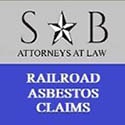
Asbestos was widely used in the railroad industry for its heat-resistant properties, which made it an ideal material for insulating steam engines and other train components. Its durability and resistance to fire made it a popular choice for various parts of the railway infrastructure. However, this extensive usage put countless workers at risk of exposure, leading to severe health issues over time. As workers carried out their daily tasks, they unknowingly inhaled asbestos fibers, which could become lodged in their lungs and cause long-term damage.
Historical Context of Asbestos Use
Before 1892, asbestos was a prevalent material in the construction and maintenance of railroad infrastructure. It was used in a variety of applications, including:
- Insulation for steam engines
- Fireproofing materials
- Brake pads and linings
- Gaskets and seals
Despite its widespread use, the dangers of asbestos were not well understood until much later. As a result, many workers were unknowingly exposed to this hazardous material. The lack of awareness and protective measures during that time meant that generations of workers faced significant health risks, a burden that would manifest in later years. It wasn’t until the latter half of the 20th century that regulations began to catch up with scientific understanding, and efforts were made to limit asbestos use and protect workers.
Health Risks Associated with Asbestos Exposure
Asbestos exposure can lead to serious health problems, including asbestosis, lung cancer, and mesothelioma. These diseases typically develop years after exposure, making early detection and testing crucial for affected individuals. The latency period of these diseases means that symptoms often do not appear until decades after the initial exposure, complicating diagnosis and treatment. Understanding these health risks is essential for former and current railroad workers to seek appropriate medical evaluation and care.
Asbestosis
Asbestosis is a chronic lung disease caused by inhaling asbestos fibers. Symptoms include shortness of breath, persistent cough, and chest pain. As the disease progresses, it can lead to respiratory failure and heart problems. This condition develops over time, as scar tissue forms in the lungs, impairing their function and causing significant discomfort. Managing asbestosis requires medical intervention to alleviate symptoms and prevent further lung damage, highlighting the importance of regular health check-ups for at-risk individuals.
Lung Cancer
Exposure to asbestos increases the risk of developing lung cancer. Symptoms may include a persistent cough, chest pain, and difficulty breathing. Early diagnosis and treatment are essential to improve outcomes. Lung cancer associated with asbestos exposure often necessitates a comprehensive treatment plan, including surgery, chemotherapy, and radiation therapy. Recognizing the signs early can lead to more effective treatment options and a better prognosis for those affected.
Mesothelioma
Mesothelioma is a rare and aggressive cancer that affects the lining of the lungs, abdomen, or heart. It is primarily caused by asbestos exposure. Symptoms can include chest pain, shortness of breath, and unexplained weight loss. Mesothelioma is notoriously difficult to treat due to its aggressive nature and late-stage diagnosis. Research into new therapies continues, but the best defense remains early detection and prevention through awareness and testing.
Importance of Asbestos Testing for Railroad Workers
Testing for asbestos exposure is a critical step in protecting the health of railroad workers. Early detection of asbestos-related diseases can significantly improve treatment outcomes and quality of life. By identifying the presence of asbestos fibers in the body early, medical professionals can tailor interventions more effectively, potentially slowing disease progression and improving patient prognosis. Asbestos testing is not just about diagnosing disease; it’s about empowering workers with the knowledge to make informed health decisions.
When to Get Tested
If you worked in the railroad industry, especially before 1892, you should consider getting tested for asbestos exposure. Additionally, if you experience any symptoms associated with asbestos-related diseases, consult a healthcare professional as soon as possible. Even if symptoms are not present, regular screenings can provide peace of mind and catch potential issues before they become severe. Being proactive about your health can make all the difference in managing potential asbestos-related conditions.
Types of Asbestos Testing
There are several methods for detecting asbestos exposure, including:
- Chest X-rays: These can reveal changes in the lungs caused by asbestos exposure.
- Pulmonary Function Tests: These assess how well your lungs are functioning and can help identify breathing issues related to asbestos exposure.
- CT Scans: These provide detailed images of the lungs and can help detect early signs of asbestos-related diseases.
Each testing method provides a different perspective on lung health, and together they form a comprehensive approach to monitoring and diagnosing potential asbestos-related issues. Consulting with healthcare professionals who specialize in occupational medicine can ensure the most appropriate and effective testing strategy is employed.
Legal Assistance for Affected Railroad Workers
If you have been exposed to asbestos while working in the railroad industry, you may be entitled to compensation. Legal assistance can help you navigate the complexities of asbestos-related claims and secure the compensation you deserve. Filing a claim can be a daunting process, filled with legal jargon and procedural hurdles, but with the right guidance, affected workers can pursue justice and potentially alleviate the financial burden of medical expenses.
Choosing the Right Law Firm
Selecting a law firm with experience in handling asbestos claims is crucial to achieving a favorable outcome. Sammons & Berry Law Firm is a reputable choice for railroad workers seeking legal assistance. Their experience in navigating the complexities of asbestos litigation can be invaluable to those unfamiliar with the legal process. A firm with specialized knowledge in asbestos-related cases can provide strategic insights and dedicated support throughout the legal journey.
Why Choose Sammons & Berry Law Firm?
- Expertise in Asbestos Claims: The firm has a proven track record of successfully handling asbestos-related cases, ensuring that clients receive the compensation they deserve.
- Client-Focused Approach: Sammons & Berry prioritizes the needs of their clients, offering personalized attention and support throughout the legal process.
- Commitment to Justice: The firm is dedicated to holding responsible parties accountable and securing justice for affected individuals.
In choosing a law firm, it’s important to consider not just their expertise, but also their commitment to their clients’ well-being and their ability to effectively communicate and advocate on behalf of their clients. Sammons & Berry’s approach ensures that clients feel supported and informed every step of the way.
Occupational Health and Safety Measures
Preventing asbestos exposure is crucial for protecting the health of railroad workers. Employers and employees must work together to implement effective safety measures. By fostering a culture of safety and awareness, the risks associated with asbestos exposure can be significantly minimized. Proactive measures in the workplace not only protect current workers but also set a precedent for future generations.
Employer Responsibilities
Employers should take the following steps to minimize asbestos exposure:
- Conduct regular asbestos risk assessments in the workplace.
- Provide protective equipment and training for employees handling asbestos-containing materials.
- Ensure proper ventilation and containment measures are in place to reduce airborne asbestos fibers.
Employers have a legal and moral obligation to ensure the safety of their employees, which includes proactive steps to manage and mitigate asbestos risks. Comprehensive training programs and regular updates on safety protocols are essential components of a robust occupational health strategy.
Employee Responsibilities
Employees can protect themselves by:
- Following safety protocols and using protective equipment when working with asbestos-containing materials.
- Reporting any suspected asbestos exposure to their employer immediately.
- Participating in regular health screenings and asbestos testing.
Taking personal responsibility for safety can greatly reduce the risk of exposure. Workers should feel empowered to speak up about safety concerns and participate actively in safety training sessions. By being vigilant and informed, employees can play a key role in maintaining a safe working environment.
Choose Sammons & Berry Law Firm
Asbestos exposure remains a significant concern for railroad workers, particularly those employed before 1892. Understanding the risks, getting tested, and seeking legal assistance are essential steps in protecting your health and securing compensation for any harm suffered. By working together, employers and employees can create a safer work environment and reduce the risks associated with asbestos exposure. Taking these steps not only protects individual health but also contributes to a broader culture of safety and responsibility.
For more information on asbestos claims and legal assistance, visit https://railroadasbestosclaims.com/qualify/. Stay informed and take action to protect your health and well-being. The journey to safer work environments begins with awareness and proactive measures, ensuring that the lessons of the past are not forgotten but used to forge a safer future.
See if you qualify for compensation
Sammons & Berry, P.C.
800-519-1440
View our Google Listing


